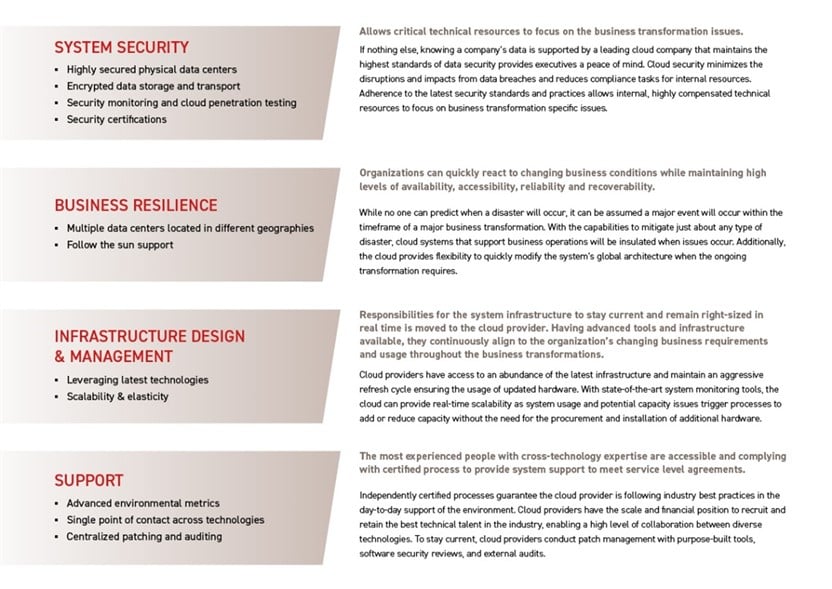This blog is the second installment of a two-part discussion on how to uncover the value of PLM SaaS. In this post, I’ll discuss how the right solution will improve IT capabilities and support future growth and the complexity of a PLM system.
Last year, Tech-Clarity conducted a survey of over one hundred manufacturers to understand their cloud strategies. The results stated, “…about three-quarters of companies favor, prefer, or mandate the cloud for their new software selections. In fact, only 4% of responding companies say they do not consider or allow the cloud.” This statement was particularly interesting because Tech-Clarity reported, in an earlier survey, “Only 17% of companies participating in our 2018 study had a software strategy that called for only using the cloud, using the cloud unless no capable solution was available, or preferring the cloud.”1
Similarly, CIMdata recently stated in their 2023 Market Analysis Report Series, “In most of CIMdata’s industrial consulting engagements today, the question is “why not cloud?” with a lot of push coming from corporate IT and even the C-suite.” 2
While these data points demonstrate the strong intention of organizations to move their systems to the cloud, they have been hesitant to migrate their PLM solution.
So, what is taking so long?
Building a compelling business case
Part 1 of this blog series discussed the difficulty many organizations experience creating a business case for migrating their PLM to a cloud SaaS solution. While the justification for moving to a SaaS offering may intuitively make sense to most IT professionals, it is often difficult to express the strategy's benefits and return on investment (ROI) within the constraints of an Excel template. The earlier blog examined how a favorable business case focuses on investing in a flexible cloud PLM solution to improve business transformation capabilities rather than just the tactical adoption of a cloud strategy. In other words, the right SaaS PLM creates value by enabling the company’s business transformational objectives, not just its cloud adoption strategy.
Choosing the right PLM solution means favoring functionality with flexibility while at the same time using industry best practices to support a company’s transformation vision are critical to the long-term success of the investment. Being able to exploit the solution’s flexibility with contemporary technology and professional expertise enhances the solution’s growth and value.
A few of the many examples of valuable cloud functionality and processes include:
- The use of cloud services in the architecture
- Adherence to independently certified best practices for security, confidentiality, and availability
- The ability to monitor and quickly adapt the solution and system architecture of the ever-changing PLM solution
Adding value to business transformations
Executing a business transformation rarely goes as planned. Business conditions usually change throughout the development process leading to changes in requirements or even the objective of the program. Since PLM systems often play a critical role in the execution of a transformation, it is important that the system in place can adapt quickly to evolving requirements. PLM on the cloud brings unique capabilities to help mitigate the impact of change.
As a simple example, let’s say a company’s business transformation plan changes to include a significant number of additional users from different parts of the world due to an acquisition and reorganization. A PLM cloud deployment can add capacity without the overhead of procuring new hardware and, if necessary, move the location of the system’s primary data center to a different data center physically closer to the users – all while already having local support resources. If the PLM deployment is on the cloud, this process would have minimal impact on the project architecture.
Differentiators for using the cloud over a traditional on-premises deployment can usually be attributed to one of two categories:
- Working with the benefits on a massive scale. Major cloud providers have the capabilities to work faster and more effectively than a company’s internal data center. From recruiting and retaining the best technical expertise, investing in automation tools, or maintaining a nearly endless amount of hardware, they can provide a faster time to value and better total cost of ownership for the PLM system than an organization’s internal IT function.
- The best people working on the right tasks. When system architecture tasks like designing and implementing the infrastructure are offloaded to a cloud provider, critical internal resources can focus on the solution architecture. By utilizing company and business-specific knowledge more effectively, these expensive resources will add more value to developing the organization’s transformation plan than working on the design of the cloud’s system architecture. The cloud provider already has cloud experts on hand and can execute the tasks equally well, if not better.
The chart below (Figure 1) provides a more detailed view of how the benefits of the cloud can impact a company’s business transformation effort.

Figure 1: Cloud impact on business transformation efforts
Expanding the cloud’s value with Software-as-a-Service (SaaS)
While companies are able to gain value from the cloud through infrastructure-as-a-service (IaaS) deployments, they may also be missing a big opportunity. While IaaS provides the infrastructure and resources to best manage the cloud architecture, it leaves the customer to manage the deployment of the enterprise software on their own.
PLM solutions can be very complex to implement due to large volumes of data, highly secure IPs, integrations with other systems, and the global footprint of many customers. Since most companies are not able to retain specific technical expertise for every enterprise application, they may not have the experience to optimally configure the architecture for a specific system.
These gaps can easily lead to systems or performance issues that take time and consultants to correct. This is where SaaS PLM adds value. There are several software vendors that offer flexible SaaS PLM solutions employing the most knowledgeable product professionals. These technical resources specialize in the PLM product and ensure the architecture is designed specifically to leverage the best of the cloud.
Working with a SaaS offering also provides customers with a more streamlined support process. When a customer experiences a production issue with an IaaS deployment, it is up to the customer to coordinate with the cloud provider, PLM software provider, third-party software provider, development partners, and anyone else to determine the root cause and coordinate with the vendors until a solution is implemented. Suppose a system becomes unavailable with a SaaS deployment. In that case, the SaaS vendor is often responsible for coordinating and correcting the issue, regardless of whether it’s a cloud or software issue.
Individuality in a SaaS world
Henry Ford once described the customer options for his Model T Ford, stating, “Any color the customer wants, as long as it's black.” He might have enjoyed today’s conversations between many PLM software vendors and their customers, where vendors inform customers that in order to move to their SaaS offering, they will need to remove or “de-customize” years of custom functionality in their PLM solution. Many PLM products have limited or eliminated the customer’s ability to customize their SaaS solution to meet specific, individual requirements. This is not a realistic approach and is not sustainable for any large company. Tech-Clarity’s research concurred by stating:
“Manufacturers must recognize the need to manage the lifecycle of the enhancements and understand the ability for their cloud PLM architecture and policies to support effective customization. The State of Cloud PLM 2022 survey found that a full 87% of manufacturers that customized PLM say they will at least "most likely" need to keep their customizations when they upgrade their PLM system, and 40% say they "definitely" will. Therefore, it's vital to minimize the ongoing support cost, sometimes called the "tail" or "technical debt." 3
For SaaS PLM to provide value in business transformations, the technology of the PLM solution will require the ability to customize the solution to meet customers’ requirements. Furthermore, these customizations must be upgradable on the customer’s schedule. As Gartner® stated in “How to Plan for a Successful Adoption of SaaS PLM.”
“Assure that the needs of customizations for your enterprise PLM are met. The SaaS PLM model encourages the use of out-of-the-box functionalities and maximizes the use of configuration. At the same time, PLM vendors must support required customization capabilities. This support can be in terms of extended SaaS custom services, providing DevOps-based custom code deployment process and plugins and open APIs, including low-code, that allows rapid customization within a set of specific guidelines.” 4
Learn more!
Gartner’s strategic planning assumption for PLM solutions asserts “By 2026, 50% of midsize and large manufacturers will adopt SaaS — PLM, design and simulation — tools compared with fewer than 20% today.” 4
Even though PLM migration to the cloud has taken longer than most analysts initially predicted, indications are this is a quickly growing area of focus. Understanding where the business value is hiding and having realistic expectations for the cloud and SaaS are important factors justifying any investment.
To hear additional insights on understanding the business value of SaaS PLM, register for the Aras webinar, “Letting Business Value Drive Cloud PLM Transition,” featuring Jim Brown, president of Digital Innovation Research at Tech-Clarity. Learn how to align SaaS PLM with your business objectives and drive maximum value from your cloud solution.
References
- Tech-Clarity, “Manufacturers Adopting Cloud Innovation Platforms”, 2019.
- CIMdata, “CIMdata 2023 Market Analysis Report Series; Executive PLM Market Report”, July 2023
- Tech-Clarity, “Achieving the Business Value of Cloud PLM”, 2023.
- Gartner, “How to Plan for a Successful Adoption of SaaS PLM”, DOC G007834732023, January 2023.GARTNER is a registered trademark and service mark of Gartner, Inc. and/or its affiliates in the U.S. and internationally and is used herein with permission. All rights reserved.

